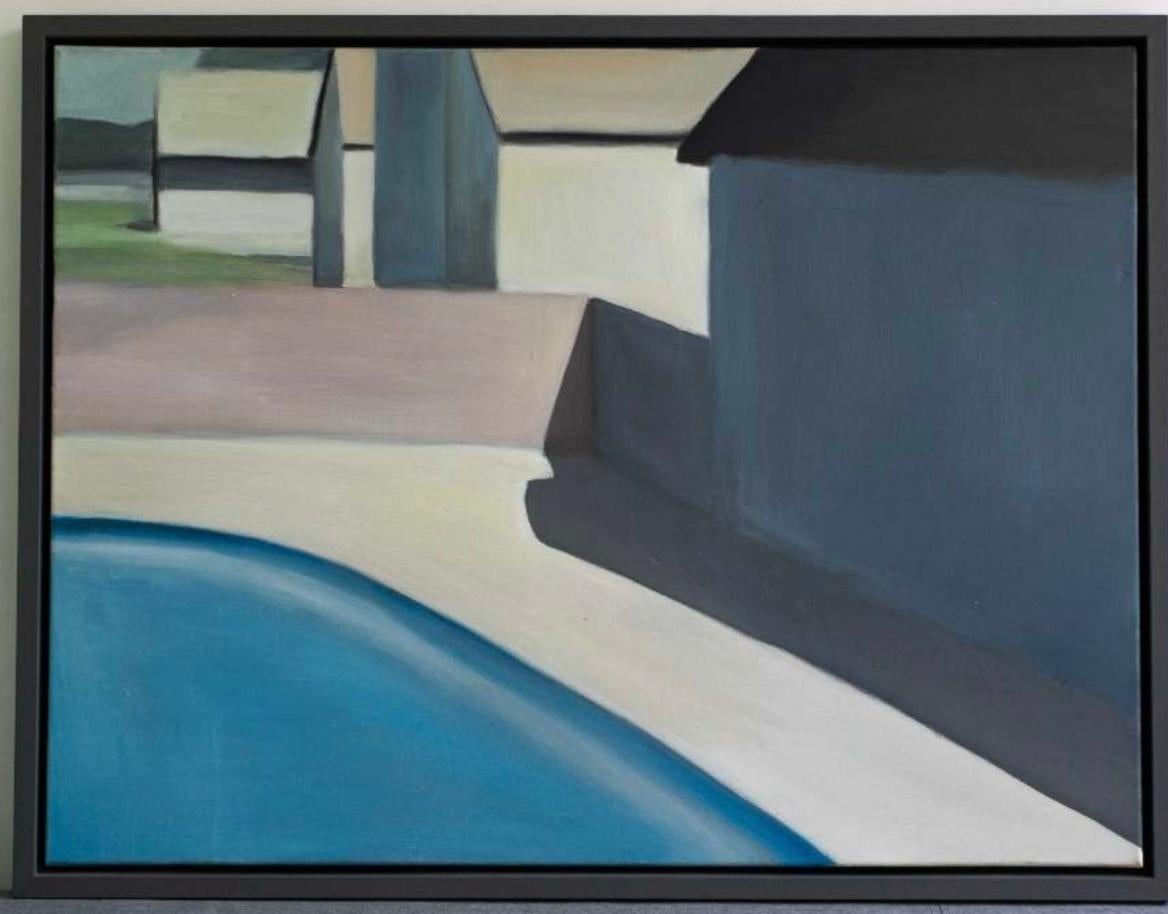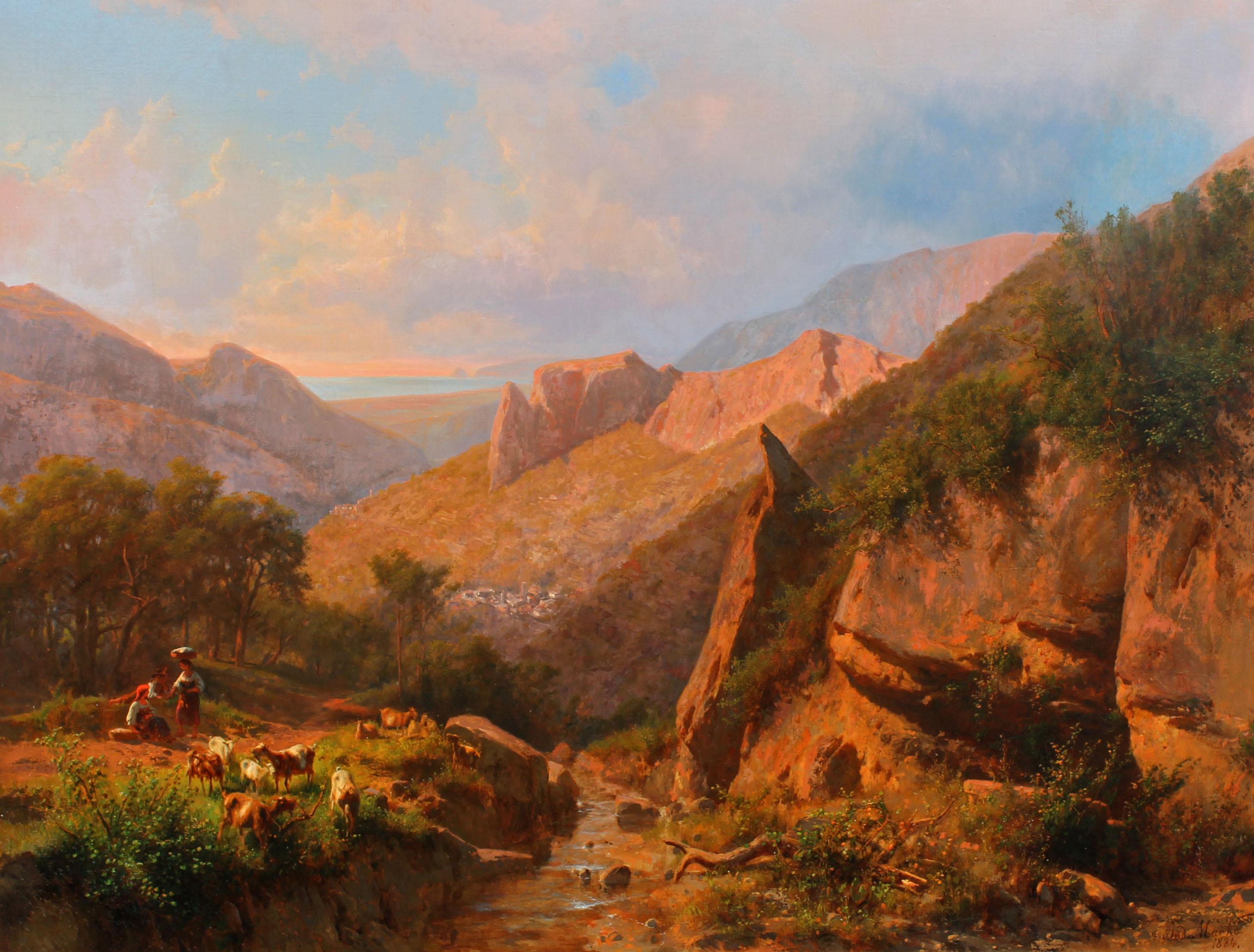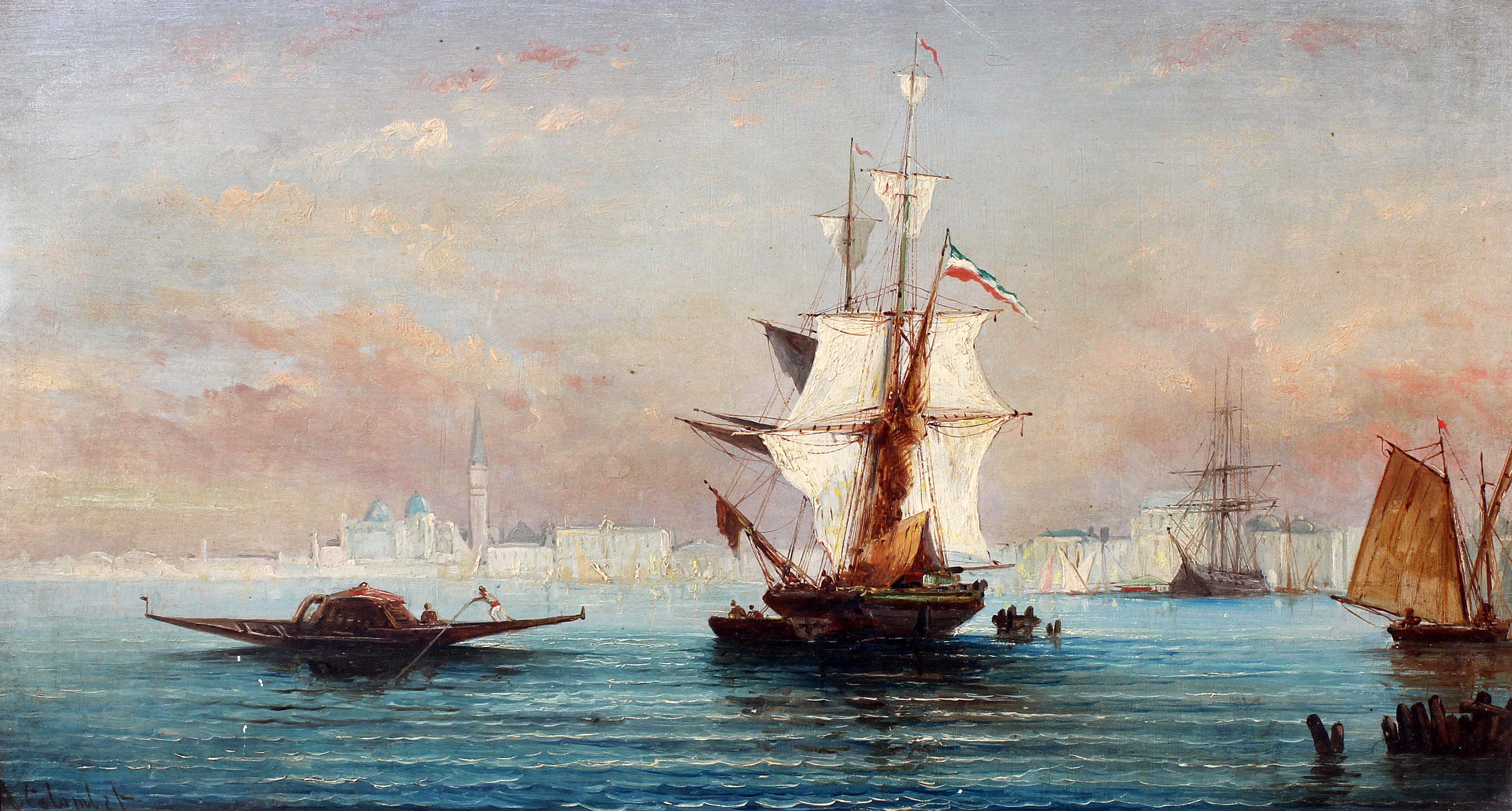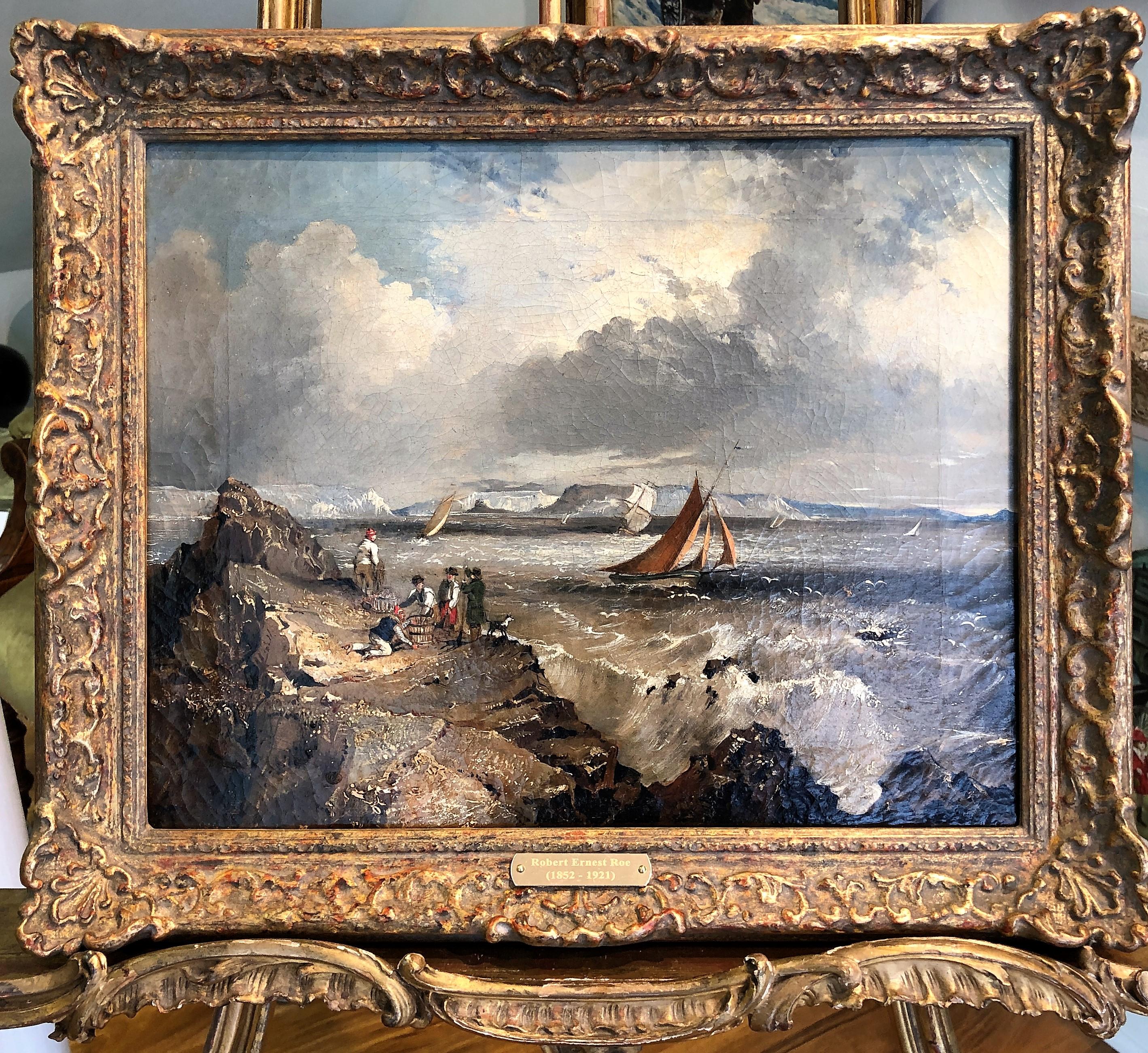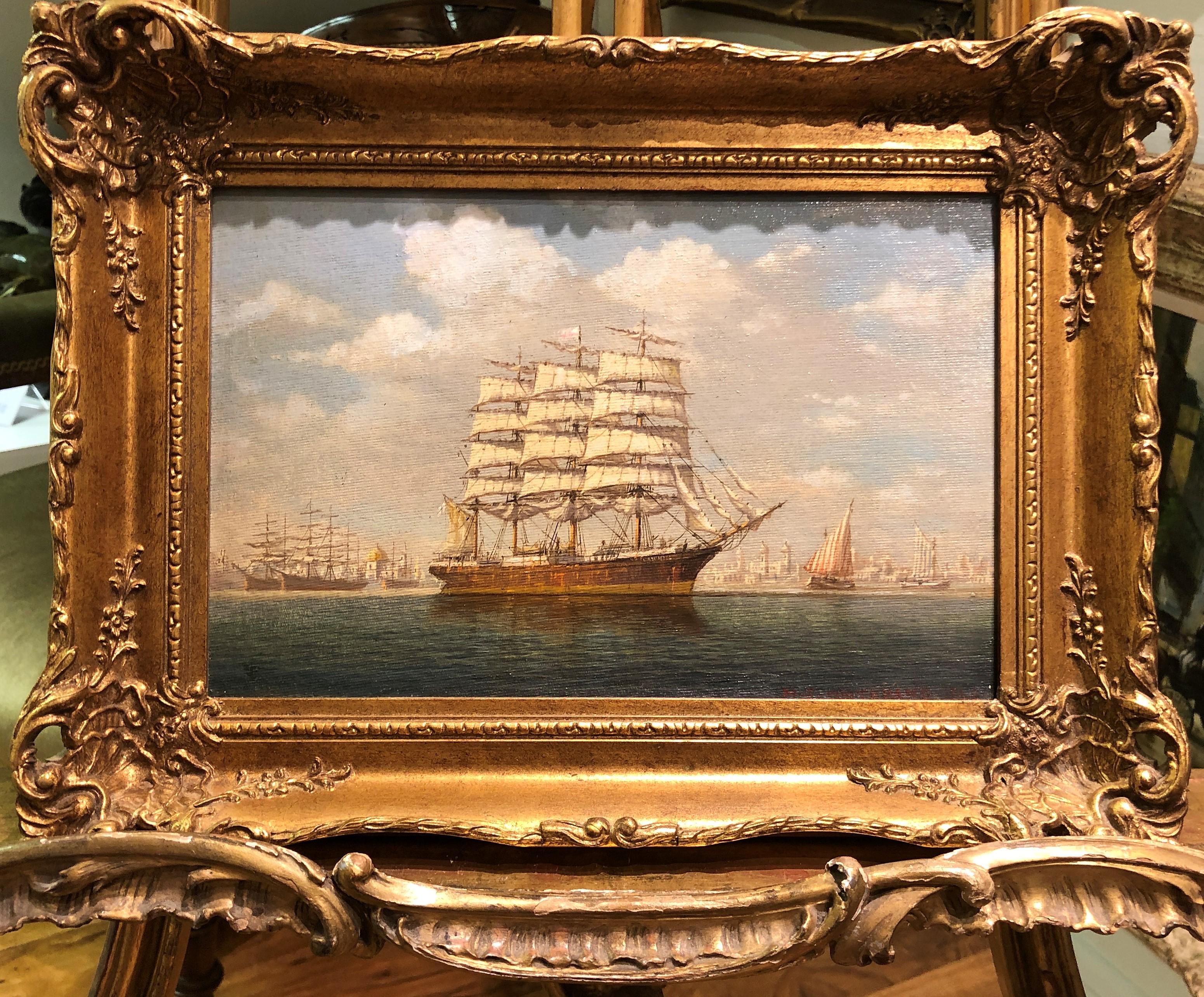Items Similar to Children with geese in the light of a summer evening
Want more images or videos?
Request additional images or videos from the seller
1 of 10
Magda KremerChildren with geese in the light of a summer evening
About the Item
Magda Kremer (*1942 Hengelo), Children with geese in the light of a summer evening. Oil on canvas, 40 x 50 cm (inside measurement), 52 x 62 cm (frame), signed by hand with "M.[agda] Kremer" on the lower right.
- in very good condition
- The Lightness of Light -
About the artwork
On a summer meadow, illuminated by the warm evening light, are two children, perhaps brother and sister. Immediately beside them are geese, turned away from the children and gradually moving to the right, probably on their way to roost. One goose is stretching its wings, another is still looking for something to eat before heading home.
The girl has crouched down and stopped picking flowers to look at the geese, while the boy standing behind her looks in our direction with one hand in his pocket and the other holding a filigree branch.
The branch is a symbol of the summery, carefree lightness of the scene, which, in addition to the motif, is carried above all by the effect of color and light.
The colors, applied in a broad Impressionist style, have a light-saturated pastel quality and seem to be almost concentrated forms of light itself. Here Magda Kremer follows the art of August Renoir and carries it into a post-impressionist figurative painting.
About the artist
Magda (Klaes) Kremer was a student of Riemko Holtrop. She made study trips to France, Spain and Portugal. Her work has been exhibited in Germany, Portugal, Switzerland and France.
GERMAN VERSION
Magda Kremer (*1942 Hengelo), Kinder mit Gänsen im sommerlichen Abendlicht. Öl auf Leinwand, 40 x 50 cm (Innenmaß), 52 x 62 cm (Rahmen), rechts unten mit „M.[agda] Kremer.“ handsigniert.
- in sehr gutem Zustand
- Die Leichtigkeit des Lichts -
zum Kunstwerk
Auf einer vom warmen Abendlicht beschienenen sommerlichen Wiese sind zwei Kinder zu sehen – vielleicht Bruder und Schwester. Unmittelbar bei Ihnen befinden sich Gänse, die von den Kindern abgewandt sind und sich allmählich nach rechts bewegen, wohl, um den Weg zu ihrer Schlafstätte anzutreten. Eine Gans ist dabei, ihre Flügel zu recken, eine andere hält noch nach etwas Essbarem Ausschau, bevor der Heimweg angetreten wird.
Das Mädchen hat sich hingehockt und hält beim Blumenpflücken inne, um die Gänse zu betrachten, während der hinter ihr stehende Junge in unsere Richtung schaut, dabei eine Hand in die Hosentasche gesteckt hat und mit der anderen einen filigranen Zweig hält.
Der Zweig ist gleichsam Sinnbild für die sommerlich unbeschwerte Leichtigkeit der Szenerie, die neben dem Motiv vor allem von der Farb- und Lichtwirkung getragen wird.
Die in breitem impressionistischem Duktus aufgetragenen Farben haben eine lichtgesättigte Pastellqualität und scheinen beinahe Konzentrationsformen des Lichtes selbst zu sein. Magda Kremer schließt hier an die Kunst eines August Renoir an und trägt diese in eine nachimpressionistische figürliche Malerei hinein.
zur Künstlerin
Magda (Klaes) Kremer war Schülerin von Riemko Holtrop. Sie unternahm Studiereisen nach Frankreich, Spanien und Portugal. Ihre Werke wurden u.a. in Deutschland, Portugal, der Schweiz und Frankreich ausgestellt.
- Creator:Magda Kremer (1942, Dutch)
- Dimensions:Height: 20.48 in (52 cm)Width: 24.41 in (62 cm)Depth: 1.97 in (5 cm)
- Medium:
- Movement & Style:
- Period:
- Condition:
- Gallery Location:Berlin, DE
- Reference Number:1stDibs: LU2438212766642

About the Seller
5.0
Vetted Seller
These experienced sellers undergo a comprehensive evaluation by our team of in-house experts.
Established in 2014
1stDibs seller since 2023
7 sales on 1stDibs
Typical response time: 7 hours
- ShippingRetrieving quote...Ships From: Berlin, Germany
- Return PolicyA return for this item may be initiated within 14 days of delivery.
More From This SellerView All
- Landscape with Trees by a Lake - Eternal summer silence over an abysmal lake -Located in Berlin, DEAndreas Thomas Juuel (1816 Copenhagen - 1868 Copenhagen). Summer landscape with tall deciduous trees by a lake. Oil on canvas, 54,5 x 42 cm (visible size), 71 x 58 cm (frame), signed...Category
1850s Realist Landscape Paintings
MaterialsOil
- Autumn Landscape in Sunlight - Indian Summer -Located in Berlin, DEFrederick Vezin (1859 Torresdale Philadelphia - 1933 Düsseldorf), Autumn Landscape in the Sunlight, oil on canvas, mounted on cardboard, 32 x 41 cm (inside measurement), 44 x 51 cm (...Category
Early 1900s Impressionist Landscape Paintings
MaterialsOil, Cardboard
- Two countrywomen with a donkey - Melancholy in an atmosphere of colour -Located in Berlin, DEPierre Louis De La Rive (1753 Geneva - 1817 Geneva). Two countrywomen with a donkey. Oil on canvas, mounted, 27 x 20 cm (visible size), 37 x 31 (frame), monogrammed "P.R." at lower right. About the artwork De La Rive has taken the typical scenes of Dutch landscape genre paintings...Category
1790s Old Masters Figurative Paintings
MaterialsCanvas, Oil
- Late Summer River Landscape / - Realistic Impression -By Jan Hillebrand WijsmüllerLocated in Berlin, DEJan Hillebrand Wijsmuller (1855 Amsterdam - 1925 ibid.), Late Summer River Landscape, oil on canvas, relined, 34 x 56 cm (inside measurement), 43 x 64 cm (frame), signed J[an] H[illebrand] Wijsmuller at lower right. - in good condition, the frame with isolated bumped spots - Realistic Impression - About the artwork The panoramic landscape format shows a river landscape, with the course of the river, which curves to the right, leading the eye into the depths of the picture and tempting it to continue the landscape in the imagination beyond the visible area. At the same time, however, the fact that the landscape is not visible through the bend in the river focuses our gaze on the entirety of the landscape depicted, without prompting us to focus on distant details. Accordingly, the brushstroke is not designed to render details with realistic precision. In the front left area of the river there is even a completely free brushwork, trained by Impressionism, which nevertheless remains committed to representational and convincingly suggests the movement of the water. Regardless of the distance of the observer, the entire picture is painted with the same broad brushstroke, so that the landscape is given as an impression. And yet this impression is not ephemeral, as in the case of French Impressionism, to put it exaggeratedly, but reveals to us the essence of the landscape in all its richness. This is why the Dutch variant of Impressionism is always also a realism, although the pictures appear less progressive, but still contain a dimension of landscape painting that is lost with progress. In the impression, the reality of the landscape is revealed, and this happens as we experience the landscape in the visual impression. Wijsmuller does not depict houses or people in order to allow the experience of the landscape to fully unfold. The experience is determined first and foremost by the river, which does not flow into the picture from our point of view, but towards us. Where the river begins to bend, the water is churned by a rapids. Toward us, the riverbed widens and the water comes to rest, covering the entire width of the foreground like a mirror. The stillness of the water corresponds to the evening mood of the late summer landscape, in which the warm tones of the evening light blend with the yellow and brown tones of the plants. A gentle, almost idyllic reality, carried by the brushstroke, yet animated by a liveliness that is also made visible by the brushstroke. The broad, dynamically placed brushstrokes evoke the movement of the treetops and animate even the immobile reeds, while the trunks on the right bank, executed in virtuoso white strokes that seem like markings, make the sunlight shine. On the other bank, a carpet of light also spreads out, its energetic effect again expressed in the brushstroke. The dynamic of the landscape is further enhanced by the complementary color contrasts between the greens, yellows, and browns on the one hand and the blue of the all-encompassing sky on the other. A contrast that is intensified by the reflection in the water. The evening coming to rest of the landscape is thus at the same time an all-encompassing contrasting and yet in itself harmonious movement. This reality becomes accessible to us as an experience in the impression of the landscape. About the artist Jan Hillebrand Wijsmuller entered the Royal Academy of Arts in Amsterdam in 1876 and studied under the innovative Professor August Allebé, who was famous for the Amsterdam Impressionism, also known as the Allebé School. In 1877, Wijsmuller transferred to the Hague Academy of Art, and thus to the Hague School, and then completed his studies at the Brussels Academy of Art. Returning to the Netherlands, Wijsmuller opened his own studio in Amsterdam. In 1883 he won the prestigious Young Artist Award, donated by Willink van Collen, which made Wijsmuller a well-known and sought-after artist. Wijsmuller was a member of the Societät Arti et Amicitiae Amsterdam and the Pulchri Studio in The Hague. Wijsmuller belongs to the second generation of the Hague School. While Vincent van Gogh described the protagonists of the first generation to his brother Theo as "the great gray people," the second generation, and Wijsmuller in particular, used a much more colorful palette. His oeuvre makes him a major player in Dutch Impressionism...Category
1890s Impressionist Landscape Paintings
MaterialsCanvas
- Small Nude / - Abstract Figurativity -Located in Berlin, DEGustl Stark (1917 Mainz - 2009 ibid.), Small Nude, 1946. Oil on canvas, marouflaged, 54 x 25 cm (picture), 30 x 60 cm (frame), signed "Stark" top left, verso twice signed "Gustav Stark", inscribed by hand as "Small Nude" and dated by hand "1946". With label of the exhibition of the Bundeshaus Bonn from 1956. - Rubbed area in the lower third of the body, at the same level a retouch in the ochre background. I provisional frame. - Abstract Figurativity - About the artwork During the war, Gustl Stark suffered a particularly severe blow for an artist: he lost his right arm. Nevertheless, he continued to devote himself to art, and the painting, created in 1946, immediately after the end of the Nazi reign of terror, testifies to the dawn of a new era. At the same time, the work is a rare example of the artist's early figurative work, as Stark turned entirely to abstract painting as early as 1950. And even this painting is by no means purely figurative; rather, it already illustrates Stark's turn toward abstraction. We see a female nude, but one that remains faceless. This can be read symbolically and in relation to the immediate past epoch, which, in the face of horrors, silences and blinds - literally renders faceless. In this sense, the figure is positioned to 'look back'. But she does not look. While this meaning may resonate and make the painting an important work of the immediate postwar period, Gustl Stark is primarily concerned with something else here, namely art itself. The absence of the face leads to the body becoming something flat. Due to the de-individualization, we do not see a concrete person with his individual features, but a body surface. And indeed, the body is constructed through an extremely planar design. Even the contour lines that form the corporeality have a planar rather than a linear character, especially where they merge into shadow zones of almost the same color. And the surfaces themselves are not modeled. The incarnate parts do not show any plastic gradations; the corporeality is completely withdrawn into the plane, which is also true for the hair. In addition, there is no uniform background against which the figure could appear; rather, the area next to the hair is kept bluish, creating a succession of earth-toned colored areas, which again binds the figure to the surface. Last but not least, the flatness is also forced by the painting technique. Gustl Stark paints directly, a la prima, onto the coarse canvas, whereby the structure of the painting support remains visible in the picture, and in places - around the hair, for example - the canvas itself can be seen. This structural all-over lends the picture a certain flatness. Gustl Stark thus uses the very motif that stands for the corporeality of art par excellence - the female nude - to transform the spatiality of the traditional picture into a flatness characteristic of modern art. And yet, a strong impression of corporeality is created, without being produced by a painterly modeling of the body. The oscillation between flatness and corporeality creates the intense tension of this groundbreaking painting. In Gustl Stark's oeuvre, as a consequence of the abstraction we see here, the figurative is completely stripped away in a further step, which is also a loss when looking at this early key work. About the artist Gustl Stark was the son of a woodcarver and, after an apprenticeship as a decorative painter, attended the State School of Arts and Crafts in Mainz from 1936 to 1937. Although he was severely wounded in the war and lost his right arm, he studied at the Würzburg School of Painting and Drawing from 1943-1944 and then at the Academy of Fine Arts in Nuremberg from 1944-1948. He won a state scholarship at the state art competition in Bad Ischl. Numerous study trips to Sylt, Paris, Switzerland, Austria, Italy, Holland and Belgium followed. Gustl Stark worked in Mainz and was the first artist there to focus on abstract painting. His work quickly gained international recognition, including the Salon Réaliés Nouvelles in Paris. From 1963-1970 he taught at the State University Institute for Art and Work Education in Mainz and from 1970-1975 at the Johannes Gutenberg University. Gustl Stark became particularly famous for his color embossed prints, for which he invented his own technique. Gustl Stark received numerous awards for his work. He received the Art Prize for Painting of the City of Mainz in 1962, the State Prize of Rhineland-Palatinate in 1984, and the Gutenberg Bust of the City of Mainz in 1987. Selected Bibliography Hans Vollmer (Hrsg.): Allgemeines Lexikon der bildenden Künstler des XX. Jahrhunderts, Vierter Band, Leipzig 1958, S. 344. Hans H...Category
1940s Realist Nude Paintings
MaterialsCanvas
- Mary Magdalene - Faith transforms inner into outer beauty and conquers death -By Balthasar DennerLocated in Berlin, DEBalthasar Denner (1685 Hamburg - 1749 Rostock). Mary Magdalene. Oil on copper, 37 × 32 cm (visible size), 45 x 40 cm (frame), signed and indistinctly dated "Denner 17(...)" at centre...Category
1720s Old Masters Figurative Paintings
MaterialsCopper
You May Also Like
- Grey House. Oil on canvas. Signed.Located in Paris, FRRaf Peeters is a Belgian artist represented by Boycott Gallery.Category
Early 2000s Realist Landscape Paintings
MaterialsOil
- A view of Sebastopol in the Crimea.Located in Paris, FRA view of Sebastopol in the Crimea. Oil on canvas. In a 19th century gild wood and plaster frame. This painting can be dated around 1830/1840 given the dresses worn by the women i...Category
1830s Realist Landscape Paintings
MaterialsOil
- Large Italian Mountain Landscape Painting by Andreas MarkoBy Andreas MarkoLocated in Rochester, NYA monumental Italian landscape oil painting. "Apuan Mountains" of Italy (The Italian Alps) Shepherds in the mountains with the village of Seravezza below. Painted by Andreas Marko...Category
19th Century Realist Landscape Paintings
MaterialsCanvas, Oil
- Busy Venetian Harbor Scene Italian Seascape Oil PaintingLocated in Rochester, NYVenetian harbor scene with St Marks in the background oil on oak panel. Exceptional quality. Signed illegibly lower left. From an old Philadelphia collection.Category
Mid-19th Century Realist Landscape Paintings
MaterialsWood Panel, Oil
- OIL PAINTING Antique 19thCentury By E.Horton British old master Gold Gilt FrameBy Etty HortonLocated in Ferndown, GBFINE ORIGINAL ARTIST E . Horton 19th CENTURY BRITISH OLD MASTER OIL PAINTING Fine Medium Size Original Antique 19th Century British OLD MASTER OIL PAINTING Romantic Scene GOLD G...Category
Mid-19th Century Realist Landscape Paintings
MaterialsOil
- OLD MASTER OIL PAINTING High Quality 19th CENTURY Stormy Seas Gold Gilt FrameBy James Edward MeadowsLocated in Ferndown, GBOLD MASTER OIL PAINTING High Quality 19th CENTURY Stormy Seas GGF Description Good Condition panel. Cleaned Ready to hang. " frame is in wonderful condition Fine Original Antique ...Category
Mid-20th Century Realist Landscape Paintings
MaterialsOil
Recently Viewed
View AllMore Ways To Browse
Vintage Fur Hand Warmer
Girl With Geese
40 Cm Oil On Canvas French
Vintage Paintings Children
Mary Queen Of Scotts
Vintage Medical Watch
Painting By David Garcia
Via Crucis
Isidor Kaufmann
Vintage Marcel Watch
B P John 1961
Painting Womens Pants
African Medicine Man
Vintage Nadine Dress
Long Zimmerman
Vintage Ski Canvas
Jeffrey Benjamin
Luna Carlos
